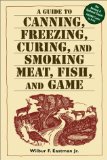Curing Meat The Old Fashioned Way for Seasonal Preservation
Curing was a widely used method of preserving meat before the days of refrigeration. Both Salt and Sugar (as well as combinations of both) have been used to cure meat by means of the process of osmosis. The higher concentration of salt in external water (Brine), actually causes moisture to evacuate the tissue. In addition to drawing the water from the food itself, salt curing also dehydrates and kills the bacterial organisms in food that are the primary agents of spoil. Although normal table salt can be used with some success, the most common types used are partly or wholly either sodium nitrite or sodium nitrate.
About Curing Brines
Sodium nitrite and sodium nitrate are the basis for two commercially used products: Prague Powders #1 and Prague Powders #2. Prague Powder #1 is a mixture of 1 part sodium nitrite and 16 parts salt. The chemicals are combined and crystallized to assure even distribution. The typical measurement for home use is 1 tsp per 5 lbs of meat. Prague Powder #2 is a mixture of 1 part sodium nitrite, .64 parts sodium nitrate and 16 parts salt. It is primarily used in dry-curing.
One other commonly available curing product is Morton’s Tender Quick. It is a mixture of salt, sodium nitrite, sodium nitrate and sugar. Butcher or specialty grocers may stock it if you aren’t inclined to mail order suppliers.
Detailed Curing & Smoking Instructions
This recipe was taken from a tiny home-made recipe book, “Remember Mama’s Recipes.” It was put together by the women of the Stirling, Alberta, LDS congregation back in the 1950’s.
Brine Cured Pork
- 100 lbs pork
- 8 lbs salt (Note: 1 part salt to 48 parts water)
- 2 oz. salt peter
- 2 lbs brown sugar
- 5 gallons water
Method:
Mix salt, brown sugar and salt peter, add this to the water and bring the mixture to a boil. Stir to dissolve sugar. Skim off any residue that may form at the surface while boiling after everything is dissolved. Remove from heat and chill until thoroughly cold.
Pack the pieces of meat into clean barrels or earthenware crocks, placing them as close together as possible. Now pour the cold brine over the meat making absolute certain the meat is completely covered (allow room for evaporation, spillage or expansion). Put a cover over the meat that just fits inside the container and place weights on it to make sure that the meat is emerged in the brine. When curing larger and smaller pieces of meat at the same time, place the larger pieces on the bottom and the smaller ones on top. This is so the smaller ones can be lifted out without disturbing the larger pieces. The small pieces do not take as long to cure as the bigger ones.
If possible, the meat should be cured in a temperature that is just above freezing. If the meat is cured at a warmer temperature the brine must be watched for signs of souring. If this should happen, remove the meat and soak it in lukewarm water for an hour or so. Wash the meat in fresh cold water and be sure to throw out the soured brine. Clean out the container, repack the meat and make a fresh brine in original proportions.
Curing Times in Brine
- Bacon sides and loins require 2 days per pound
- Shoulders will take 3 days per pound.
- Hams will take 4 days per pound.
After the meat is cured the pieces should be soaked in warm water and then washed in cold water or even scrubbed with a brush to remove any residue that may have accumulated during the curing process.
Hang the meat by very heavy cords in a cool dry place, preferably in flour or gunny sacks to discourage airborne contaminant or pests. Allow to drain 24 hours before starting the smoking. Remove the sack before beginning smoking.
Hard wood is the best to use for smoking. The temperature should be 100-120 degrees F. Ventilation should be utilized at first to allow any moisture to escape. Smoke until desired flavor and color is arrived at. A typical time is 3 days for the largest pieces.
Additional Research:
 |
Leave a Reply